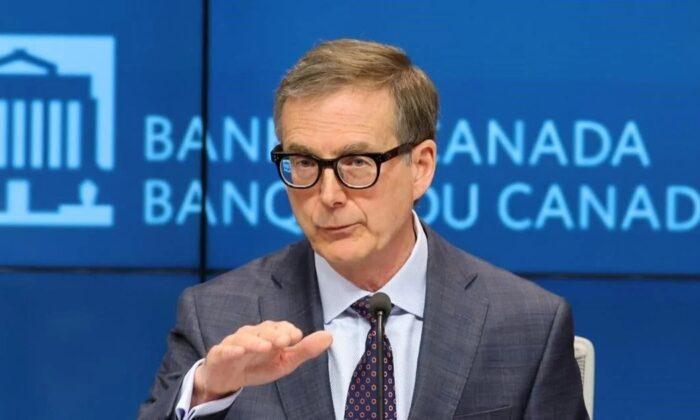OTTAWA—The Bank of Canada raised its overnight rate target by a quarter percentage point (25 basis points) to 5 percent on July 12 in response to more persistent excess demand in the economy and slowing downward momentum with inflation.
“Canada’s economy has been stronger than expected,” the BoC said in a statement.
The central bank gave no indication that it is pausing or has finished raising interest rates.
“Governing Council remains concerned that progress towards the 2 percent target could stall,” the BoC said.
In its July monetary policy report (MPR) which includes quarterly forecasts for growth and inflation, the BoC projects inflation to hover around 3 percent for the next year before returning to its 2 percent target in the middle of 2025—about two quarters later than forecasted in January and April.
Persistent inflation is being seen in services, which include things like hotels, restaurants, and travel. This is backed by the strength in the labour market where wages have been growing by 4 percent to 5 percent.
The bank says that ongoing service price inflation is an issue in many countries.
The BoC added that headline inflation has come down more due to lower energy prices but the underlying trend remains problematic. There will also be less downward momentum to inflation as the very large increases in the consumer price index from a year ago drop out of the annual calculation going forward.
May’s inflation reading of 3.4 percent is the smallest increase since June 2021, but without lower prices for gasoline, the annual inflation rate would be 4.4 percent.
The BoC’s gauges of core inflation, which try to capture the underlying trend by excluding more volatile factors, have shown less effect on the rate hikes. They’ve been at least as high as 3.8 percent since February 2022, while headline inflation has come down to 3.4 percent from its peak of 8.1 percent last summer.
“Core inflation is not yet on a firm downward trend,” the bank said in its MPR.
The bank’s business surveys reported that businesses are still raising prices more frequently than normal.
Surprising Consumer Spending
The bank said that while it expects consumer demand to slow due to interest rate increases, certain data suggests more persistent excess demand in the economy and that the housing market has “seen some pickup.”
Strong population growth from immigration is adding to both demand and supply in the economy, according to the BoC, but this is not having a direct impact on inflation. More workers ease the tightness in the labour force but newcomers to the country tend to consume more.
The labour market showed an increase of 60,000 jobs in June, but the uptick in the unemployment rate to 5.4 percent was a result of more people looking for jobs. The 5.4 percent is still at a historically very low level for unemployment.
In its MPR, the bank listed a number of factors responsible for the “unexpected strength of household spending over the first half of 2023.” These include a strong labour market, immigration, built-up household savings, pent-up demand for services, and governments’ budget spending.
The BoC says consumer spending also continues to recover from the COVID-19 pandemic and it could continue to be stronger than expected.
The bank’s updated growth forecasts include a boost for 2023 to 1.8 percent from 1.4 percent in April. The growth forecasts for 2024 and 2025 of 1.2 percent and 2.4 percent respectively are 0.1 percent lower than in April.
The BoC continues to forecast a “soft landing”—avoiding a recession with the economy growing at a slow pace, but growing nevertheless.





